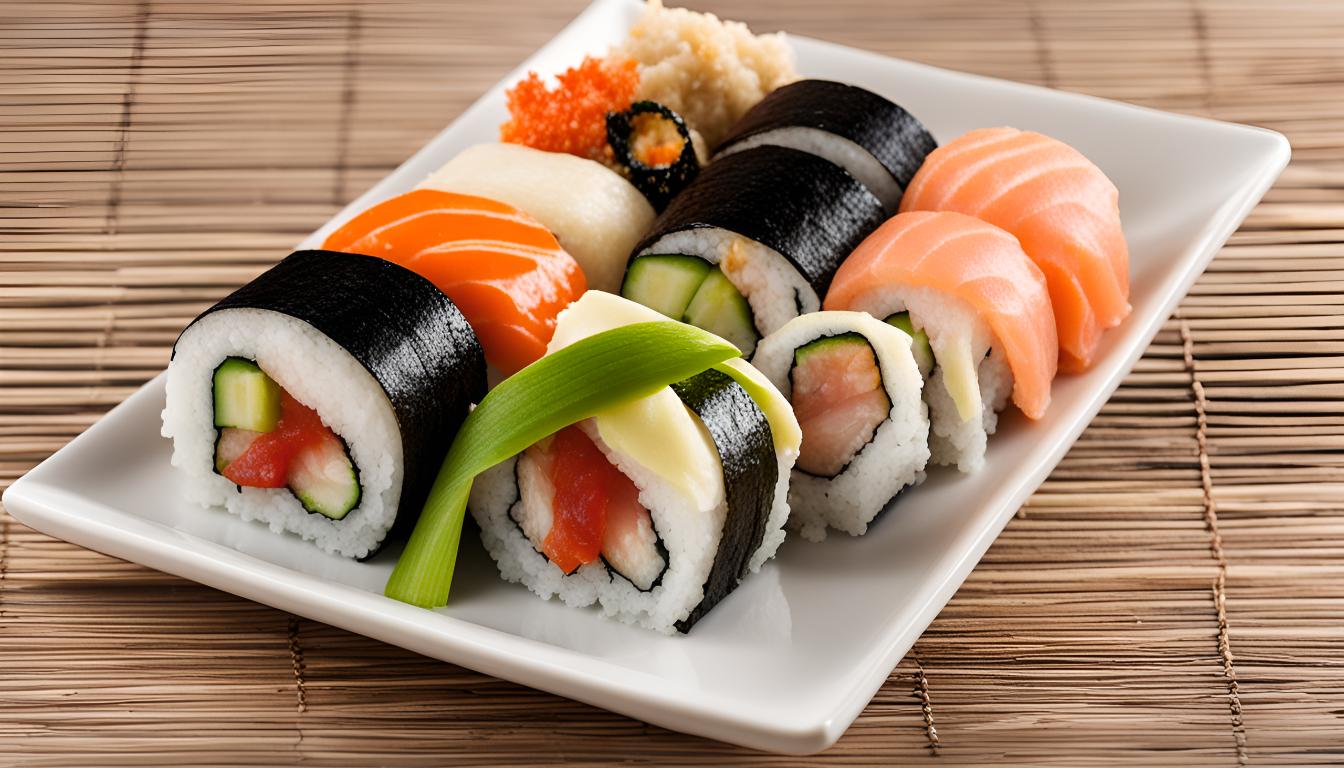Exploring Japanese Sushi Rolls (Maki): A Comprehensive Guide
Sushi rolls, or Maki in Japanese, represent a fundamental aspect of Japanese cuisine celebrated globally for their artistry, flavors, and cultural significance. Originating centuries ago in Japan, Maki has evolved into a diverse array of styles and ingredients, catering to both traditional tastes and modern innovations. In this comprehensive guide, we will delve into the history, types, ingredients, preparation methods, cultural context, and practical tips for crafting exquisite sushi rolls at home.
Historical Origins of Sushi Rolls (Maki)
The history of sushi dates back to ancient Japan, where it initially served as a method of preserving fish by fermenting it with rice. Over time, this preservation technique evolved into what is now known as Narezushi, where fish and rice were packed together and stored for several months to develop flavor.
During the Edo period (1603-1868), sushi underwent significant changes, particularly with the introduction of Edo-style sushi, which emphasized fresh fish served atop seasoned rice. It was during this period that the concept of rolling sushi with seaweed (nori) emerged, marking the birth of Maki sushi.
The evolution of sushi rolls continued into the 20th century, both in Japan and abroad, as chefs experimented with new ingredients and techniques to cater to diverse palates and dietary preferences. Today, Maki sushi remains a staple in Japanese cuisine and a symbol of culinary craftsmanship.
Types of Sushi Rolls (Maki)
Sushi rolls come in various types, each distinguished by its ingredients, rolling technique, and presentation style. Some popular types of Maki include:
1. Futomaki (Thick Rolls): These are large rolls with multiple fillings wrapped in seaweed and rice, typically cut into bite-sized pieces. Futomaki often feature a variety of colorful ingredients, such as vegetables, seafood, and omelet.
2. Hosomaki (Thin Rolls): Hosomaki are smaller rolls with a single filling wrapped tightly in seaweed and rice. Common fillings include cucumber, tuna, salmon, or avocado. These rolls are typically served as an appetizer or snack.
3. Uramaki (Inside-Out Rolls): Uramaki rolls have rice on the outside and seaweed on the inside, with fillings such as crab meat, avocado, and cucumber. They are often coated with sesame seeds or tobiko (flying fish roe) for added texture and flavor.
4. Temaki (Hand Rolls): Temaki are cone-shaped rolls filled with rice, seafood, vegetables, and other ingredients. They are meant to be eaten by hand and are popular for their portability and customizable fillings.
5. Specialty Rolls: Modern sushi chefs often create specialty rolls that blend traditional Japanese ingredients with international flavors and artistic presentations. These rolls, such as dragon rolls or rainbow rolls, showcase creativity and innovation in sushi-making.
Essential Ingredients for Making Sushi Rolls
The key ingredients for making sushi rolls include:
– Sushi Rice: Short-grain Japanese rice seasoned with rice vinegar, sugar, and salt to provide a sticky texture and slightly sweet flavor.
-Nori (Seaweed Sheets): Roasted seaweed sheets used to wrap the rice and fillings in Maki sushi. Nori adds a subtle umami flavor and crisp texture.
– Fillings: Varied fillings such as fresh fish (sashimi-grade tuna, salmon), seafood (shrimp, crab), vegetables (cucumber, avocado), and omelet (tamagoyaki).
– Condiments and Garnishes: Soy sauce (shoyu), pickled ginger (gari), wasabi (Japanese horseradish), and sesame seeds or tobiko (fish roe) for added flavor and texture.

Preparation Methods for Sushi Rolls (Maki)
Making sushi rolls requires precision and attention to detail to achieve the perfect balance of flavors, textures, and presentation. Here’s a step-by-step guide to crafting traditional Hosomaki (thin rolls):
1. Prepare Sushi Rice:
– Rinse short-grain Japanese rice until the water runs clear to remove excess starch. Cook the rice with water in a rice cooker or pot.
– Once cooked, transfer the rice to a large bowl and season with a mixture of rice vinegar, sugar, and salt. Mix gently to evenly coat the rice while fanning to cool it down.
2. Prepare Fillings:
– Slice fillings into thin strips or small pieces. Common fillings include cucumber, avocado, raw fish (sashimi-grade), and cooked seafood.
3. Assemble Ingredients:
– Place a bamboo sushi rolling mat (makisu) on a clean surface and cover it with a sheet of plastic wrap. Lay a sheet of nori, shiny side down, on the mat.
4. Spread Sushi Rice:
– Moisten your hands with water to prevent the rice from sticking. Spread a thin layer of sushi rice evenly over the nori, leaving a small border along the top edge.
5. Add Fillings:
– Arrange the desired fillings horizontally across the center of the rice-covered nori sheet.
6. Roll Sushi:
– Using the bamboo mat, lift the edge closest to you and begin rolling it away from you, tucking in the fillings tightly. Continue rolling until you reach the uncovered edge of the nori.
– Moisten the uncovered edge with water to seal the roll. Apply gentle pressure to shape the roll evenly.
7. Slice and Serve:
– Use a sharp knife dipped in water to slice the sushi roll into bite-sized pieces, wiping the blade clean between cuts. Arrange the slices on a plate and serve with soy sauce, pickled ginger, and wasabi.
Cultural Significance of Sushi Rolls
In Japanese culture, sushi is more than just a meal—it embodies traditions of craftsmanship, hospitality, and respect for seasonal ingredients. Sushi-making is considered an art form that requires years of training and dedication to perfect techniques such as rice preparation, knife skills, and presentation.
Sushi also reflects Japan’s close relationship with the sea and its commitment to sustainable fishing practices. Traditional sushi chefs (itamae) source the freshest seafood from local markets, ensuring that each piece of sushi is of the highest quality and flavor.
In Japanese dining etiquette, sushi is often enjoyed as part of a multi-course meal (kaiseki) or as a special treat during celebrations and social gatherings. It is customary to eat sushi with chopsticks, dip the fish-side into soy sauce (not the rice), and consume it in one bite to fully appreciate the flavors.
Tips for Making Perfect Sushi Rolls at Home
To achieve restaurant-quality sushi rolls at home, consider the following tips:
– Use High-Quality Ingredients: Invest in fresh, high-quality fish and seafood from reputable sources. Sashimi-grade fish is recommended for raw sushi.
– Master Sushi Rice: Pay attention to rice preparation, ensuring it is cooked to the right texture and seasoned with vinegar, sugar, and salt for authentic flavor.
– Practice Rolling Techniques: Start with simple Hosomaki rolls before attempting more complex Uramaki or specialty rolls. Use a bamboo rolling mat for even pressure and tight rolls.
– Experiment with Fillings: Get creative with fillings to suit your taste preferces and dietary restrictons. Explore combinations of vegetables, proteins, and sauces for unique flavor profiles.
– Presentation Matters: Arrange sushi rolls neatly on a plate, garnishing with sesame seeds, tobiko, or thinly sliced vegetables for visual appeal.
Conclusion
Japanese sushi rolls (Maki) represent a culinary tradition steeped in history, craftsmanship, and cultural significance. From their humble origins in ancient preservation techniques to their modern-day popularity worldwide, Maki sushi continues to captivate food enthusiasts with its exquisite flavors, artistic presentation, and versatility.
By exploring the rich heritage of sushi rolls and mastering the art of sushi-making at home, you not only embrace Japanese culinary traditions but also embark on a journey of creativity, exploration, and appreciation for the finer nuances of Japanese cuisine. Whether preparing traditional Hosomaki for a family dinner or crafting innovative Uramaki for a special occasion, sushi rolls offer a delightful sensory experience that celebrates the harmony of flavors and textures.
Through this comprehensive guide, you are equipped with the knowledge and skills to create authentic Japanese sushi rolls that honor tradition while reflecting your own culinary flair. Embrace the art of Maki sushi, and indulge in the pleasure of sharing delicious food and cultural heritage with those around you.
In conclusion




